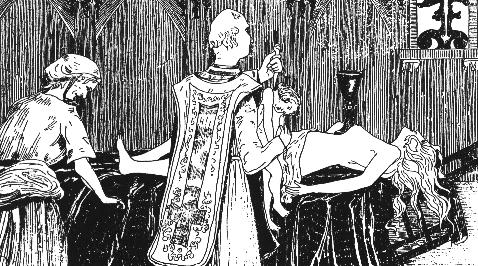 |
| Satanic Ritual Abuse |
Conspiracy-infused accusations of satanic ritual abuse (SRA) came to the forefront in U.S. culture in the mid-1980s through intense media attention, and spread to Britain and Australia, and most recently continental Europe.
Those believing in SRA, commonly known as true believers, maintained that secretive groups were involved in forcing people, mainly children, to have sex and engage in satanic rituals such as the sacrificing of babies and drinking their blood. In the United States the main period of SRA accusations is from 1984 to 1994, but this is not an entirely recent trend.
In early Christian cultures those thought to be in allegiance with the devil were believed to be involved in forms of satanic abuse. This reached its zenith in the Middle Ages with witch trials and the publication in 1481 of Malleus Maleficarum by Heinrich Kraemer and Johann Sprenger, known in English as The Witches’ Hammer.
  |
During the 1960s U.S. Christianity became focused on the personal and obsessed with personal evil, typified in Roman Polanski’s 1968 film Rosemary’s Baby. In 1969 Anton Szandor La Vey wrote The Satanic Bible and those looking for clear evidence of occult activity across the United States believed they had found it. This was followed by other texts such as The Satan Seller by self-declared ex-satanic high priest Mike Warnke in 1972, claiming that occult and SRA activity was proliferating.
In 1973 William Friedkin’s film The Exorcist shockingly depicted the results of demonic possession, and was supposedly based on fact. Personal stories, such as Michelle Remembers by Michelle Smith and Lawrence Pazder published in 1980, were taken as evidence of the existence of SRA, with no substantial proof given.
A major incident in 1984, known as the McMartin case, sparked accusations of SRA. At McMartin Preschool in Manhattan Beach, California, 360 children were diagnosed with being abused via SRA. Child abuse allegations were also levied at other schools in the area, such as St. Cross Episcopal Church in Hermosa Beach, and in all, 100 teachers were accused of belonging to a satanic cult involved in ritual molestation.
The majority of charges were dropped and the case led to further investigations into false memory syndrome, a belief that in such cases psychologists working with the victims of alleged abuse place false memories through suggestion, hypnosis, and other techniques.
However, this itself is often considered another conspiracy: false memory syndrome or recovered memory system is not a clinical medical term and was, it is alleged by believers of SRA, invented by those parents charged with abuse.
Groups such as Breaking Free, an SRA survivors’ organization, have linked SRA rings to other conspiracy theories relating to disparate groups from the Jesuits to the Freemasons, seeing SRA as another way of bringing about the New World Order.
To true believers 60,000 people are killed each year via SRA. Numerous cases may exist but evidence of a more substantial conspiracy is lacking. After the 1980s movement away from liberalism and the rise of the Christian Right during the Reagan era, in 1994 the U.S. saw a backlash against belief in SRA.
The general public, and therefore juries, became skeptical of accusations made of SRA, seeing it as the product of vivid imaginations imbued with stories from popular U.S. Christianity rather than a reality, making prosecution in such cases problematic.